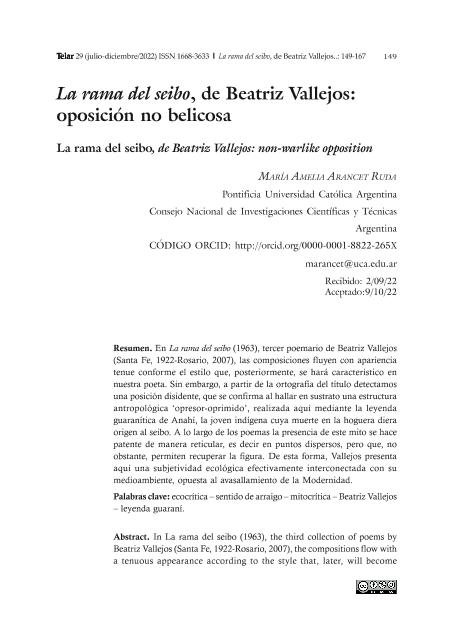Mostrar el registro sencillo del ítem
dc.contributor.author
Arancet Ruda, Maria Amelia

dc.date.available
2023-07-04T13:49:07Z
dc.date.issued
2022-12
dc.identifier.citation
Arancet Ruda, Maria Amelia; La rama del seibo, de Beatriz Vallejos: oposición no belicosa; Universidad Nacional de Tucumán. Facultad de Filosofía y Letras. Instituto Interdisciplinario de Estudios Latinoamericanos; Telar; 29; 12-2022; 149-167
dc.identifier.issn
1668-3633
dc.identifier.uri
http://hdl.handle.net/11336/202231
dc.description.abstract
En La rama del seibo (1963), tercer poemario de Beatriz Vallejos (Santa Fe, 1922-Rosario, 2007), las composiciones fluyen con apariencia tenue conforme el estilo que, posteriormente, se hará característico en nuestra poeta. Sin embargo, a partir de la ortografía del título detectamos una posición disidente, que se confirma al hallar en sustrato una estructura antropológica ‘opresor-oprimido’, realizada aquí mediante la leyenda guaranítica de Anahí, la joven indígena cuya muerte en la hoguera diera origen al seibo. A lo largo de los poemas la presencia de este mito se hace patente de manera reticular, es decir en puntos dispersos, pero que, no obstante, permiten recuperar la figura. De esta forma, Vallejos presenta aquí una subjetividad ecológica efectivamente interconectada con su medioambiente, opuesta al avasallamiento de la Modernidad.
dc.description.abstract
In La rama del seibo (1963), the third collection of poems by Beatriz Vallejos (Santa Fe, 1922-Rosario, 2007), the compositions flow with a tenuous appearance according to the style that, later, will become characteristic of our poet. However, based on the spelling of the title, we detect a dissident position, which is confirmed by finding an 'oppressoroppressed' anthropological structure in the substratum, carried out through the Guarani legend of Anahí, the young indigenous woman whose death at the stake gave rise to the seibo. Throughout the poems, the presence of this myth is evident in a reticular manner, that is, in scattered points, but which, nevertheless, allow the figure to be recovered. In this way, Vallejos presents in this book an ecological self effectively interconnected with her environment, opposed to the subjugation of Modernity.
dc.format
application/pdf
dc.language.iso
spa
dc.publisher
Universidad Nacional de Tucumán. Facultad de Filosofía y Letras. Instituto Interdisciplinario de Estudios Latinoamericanos
dc.rights
info:eu-repo/semantics/openAccess
dc.rights.uri
https://creativecommons.org/licenses/by-nc-sa/2.5/ar/
dc.subject
POESÍA
dc.subject
BEATRIZ VALLEJOS
dc.subject
FOLCLORE GUARANÍTICO
dc.subject
ECOCRÍTICA
dc.subject.classification
Literaturas Específicas

dc.subject.classification
Lengua y Literatura

dc.subject.classification
HUMANIDADES

dc.title
La rama del seibo, de Beatriz Vallejos: oposición no belicosa
dc.title
La rama del seibo, de Beatriz Vallejos: non-warlike opposition
dc.type
info:eu-repo/semantics/article
dc.type
info:ar-repo/semantics/artículo
dc.type
info:eu-repo/semantics/publishedVersion
dc.date.updated
2023-07-02T14:55:30Z
dc.journal.number
29
dc.journal.pagination
149-167
dc.journal.pais
Argentina

dc.journal.ciudad
San Miguel de Tucumán
dc.description.fil
Fil: Arancet Ruda, Maria Amelia. Consejo Nacional de Investigaciones Científicas y Técnicas; Argentina. Pontificia Universidad Católica Argentina "Santa María de los Buenos Aires"; Argentina
dc.journal.title
Telar
dc.relation.alternativeid
info:eu-repo/semantics/altIdentifier/url/http://revistatelar.ct.unt.edu.ar/index.php/revistatelar/article/view/607
Archivos asociados
